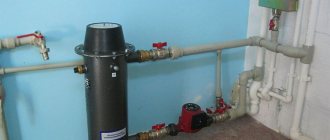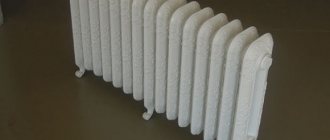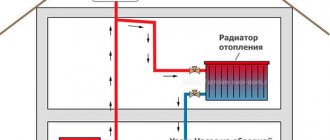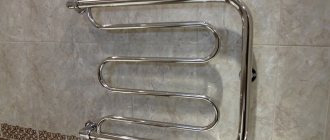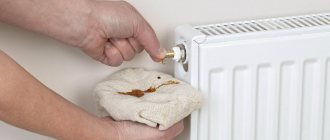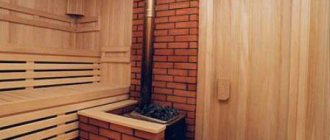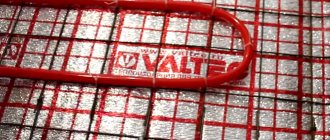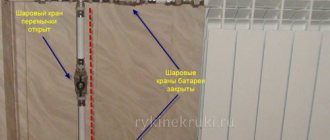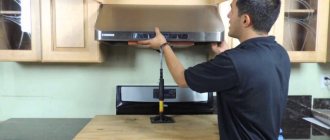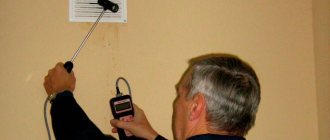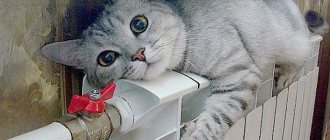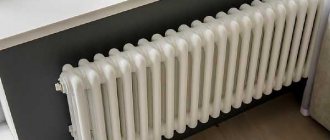Air exchange rate in retail premises (shops)
| № | Room | Estimated air temperature for the cold period of the year, °C | Air exchange rate or the amount of air removed from the premises | |
| influx | hood | |||
| 1 | Sales areas of stores with an area of 400 m2 or less: | |||
| food | 16 | — | 1 | |
| non-food | 16 | — | 1 | |
| 2 | Sales areas of stores with an area of more than 400 m2: | |||
| food | 16 | By calculation | By calculation | |
| non-food | 16 | By calculation | By calculation | |
| 3 | Razrubochnaya | 10 | 3 | 4 |
| 4 | Unloading premises | 10 | By calculation | By calculation |
| 5 | Premises for preparing goods for sale (if placed in a separate room), picking, receiving | 16 | 2 | 1 |
| 6 | Storerooms (unrefrigerated): | |||
| bread, confectionery; | 16 | — | 0,5 | |
| gastronomy, fish, milk, fruits, vegetables, pickles, wine, beer, drinks; | 8 | — | 1 | |
| shoes, perfumes, household chemicals, chemicals; | 16 | — | 2 | |
| other goods | 16 | — | 0,5 | |
| 6.1 | Room for preparing goods for sale (if placed in a separate room), picking, acceptance, expeditions | 16 | 2 | 1 |
| 7 | Premises for displaying new products (if placed in a separate room) | 16 | 2 | 2 |
| 8 | Ironing | 16 | By calculation | By calculation |
| 9 | Garbage chambers (unheated) | — | — | — |
| 10 | Room for mechanized pressing of paper waste | 16 | — | 1,5 |
| Storage facilities: | ||||
| 11 | packaging materials and equipment | 16(8) | — | 1 |
| 12 | exchange fund containers | — | — | 1 |
| 13 | containers | 8 | — | 1 |
| 14 | cleaning equipment, detergents | 16 | — | 1,5 |
| 15 | Linen room | 18 | — | 0,5 |
| 16 | Workshops, laboratories | 18 | 2 | 3(2) |
| 17 | Refrigerated containment chambers: | |||
| meat, semi-finished products, gastronomy | 0 | — | — | |
| fish | -2 | — | — | |
| vegetables, fruits, confectionery, drinks | 4 | 4 | 4 | |
| ice cream, dumplings, etc. | -12 | Periodically | ||
| food waste | 2 | — | 10 | |
| 18 | Air cooled machine rooms | 5 | By calculation | |
| 19 | Water-cooled refrigerated machine rooms | 5 | 2 | 3 |
| 20 | Office premises, staff room, main cash register, security room, automated control center | 18 | — | 1 |
| 21 | Dressing rooms, utility room for catering establishment staff, meal room | 16 | — | 1 |
| 22 | Public toilets for customers and staff toilets | 16 | — | 50 m3/h per toilet |
| 23 | Showers | 25 | — | 5 |
| 24 | Dispensary room (if the store is located in the underground floors) | 20 | — | 60 m3/h per person |
| 25 | Premises for receiving and issuing orders | 12 | — | 1 |
| 26 | Glass container reception premises | 16 | — | 1 |
| 27 | Health center | 20 | 1 | 1 |
Design air exchange
The calculated value of air exchange is taken to be the maximum value from calculations of heat input, moisture input, harmful vapors and gases, sanitary standards, compensation for local exhaust hoods and the standard air exchange rate.
The air exchange of residential and public premises is usually calculated according to the air exchange rate or according to sanitary standards.
After calculating the required air exchange, an air balance of the premises is compiled, the number of air distributors is selected, and an aerodynamic calculation of the system is made. Therefore, we advise you not to neglect air exchange calculations if you want to create comfortable conditions for your stay in the room.
Air exchange rate in the premises of public catering establishments
| № | Names of premises | Design air temperature, °C | Air change rate per hour | |
| influx | hood | |||
| 1 | Hall, distribution room | 16 | According to calculations, but not less than 30 m3/h per person. | |
| 2 | Lobby, antechamber | 16 | 2 | — |
| 3 | Cookery store | 16 | 3 | 2 |
| 4 | Hot shop, confectionery baking room | 5 | According to calculations, but not less than 100 m3/h per person. | |
| 5 | Shops: pre-cooking, cold, meat, poultry, fish, herbs and vegetables processing | 18 | 3 | 4 |
| 6 | Production Manager's Office | 18 | 2 | — |
| 7 | Room for flour products and finishing of confectionery products, linen | 18 | 1 | 2 |
| 8 | Room for cutting bread, for preparing ice cream, serving room, utility room | 18 | 1 | 1 |
| 9 | Washing: tableware, kitchen utensils, vessels, containers | 18 | 4 | 6 |
| 10 | Director's office, office, main cash register, rooms for waiters, staff, storekeeper | 18 | 4 | 6 |
| 11 | Dry food pantry, equipment pantry, wine and vodka pantry, beer storage room | 12 | — | 1 |
| 12 | Pantries of vegetables, pickles, containers | 5 | — | 2 |
| 13 | Reception | 16 | 3 | — |
| 14 | Engine room of refrigerated chambers with air-cooled units | By calculation | By calculation | By calculation |
| 15 | The same, with water-cooled units | — | 3 | 4 |
| 16 | Repair shops | 16 | 2 | 3 |
| 17 | Premises of public organizations | 16 | 1 | 1 |
| 18 | Refrigerated storage chambers: | |||
| meat | 0 | — | — | |
| fish | -2 | — | — | |
| dairy and fat products, gastronomy | 2 | — | — | |
| semi-finished products, including highly prepared | 0 | — | — | |
| vegetables, fruits, berries, drinks | 4 | 4 | 4 | |
| confectionery | 4 | — | — | |
| wines and drinks | 6 | — | — | |
| ice cream and frozen fruit | -15 | — | — | |
| food waste | 5 | — | 10 | |
| 19 | Smoking room | 16 | — | 10 |
| 20 | Unloading premises | 10 | By calculation | By calculation |
Notes: 1. The air temperatures in the rooms (except for refrigerated chambers) indicated in the table are calculated when designing heating systems.
2. In buffets, bars, cocktail lounges, banquet halls located in separate rooms, the air ratio is minus 3.
3. The air temperatures in the refrigerated chambers indicated in the table are maintained around the clock throughout the year. In chambers for the simultaneous storage of meat and fish or meat and fish semi-finished products, accept temperatures of ±0 ° C; for semi-finished vegetable products +2 °C; for storing all products (1 chamber in the enterprise) ±2 °C.
Air exchange rates
This table shows the values of air exchange rates for domestic premises: Air exchange rates for industrial premises and rooms with a significant volume:
The data presented above is taken from the directories of the famous Ukrainian company Vents.
Air flow rates for modulated equipment
| № | Equipment | Brand | kW | Air quantity, m3/h | |
| Exhaust | Supply air | ||||
| 1 | Electric stove | PE-0.17 | 4 | 250 | 200 |
| 2 | PE-0.17-01 | 4 | 250 | 200 | |
| 3 | Electric stove | PE-0.51 | 12 | 750 | 400 |
| 4 | PE-0.51-01 | 12 | 750 | 400 | |
| 5 | Frying cabinet | ShZhE-0.51 | 8 | 400 | — |
| 6 | ShZhE-0.51-01 | 8 | 400 | — | |
| 7 | ShZhE-0.85 | 12 | 500 | — | |
| 8 | ShZhE-0.85-1 | 12 | 500 | — | |
| 9 | Electric device, cooking | UEV-60 | 9,45 | 650 | 400 |
| 10 | Mobile boiler | KP-60 | — | — | — |
| 11 | deep fryer | FE-20 | 7,5 | 350 | 200 |
| 12 | Cooking kettle with capacity, l: | ||||
| 100 | KE-100 | 18,9 | 550 | 400 | |
| 160 | KE-160 | 24 | 650 | 400 | |
| 250 | KE-250 | 30 | 750 | 400 | |
| 13 | Steamer | APE-0.23A | 7,5 | 650 | 400 |
| APE-0.23A-01 | 7,5 | 650 | 400 | ||
| 14 | Electric frying pan | SE-0.22 | 5 | 450 | 400 |
| SE-0.22-01 | 5 | 450 | 400 | ||
| SE-0.45 | 11,5 | 700 | 400 | ||
| SE-0.45-01 | 11,5 | 700 | 400 | ||
| 15 | Steam table | ITU-0.84 | 2,5 | 300 | 200 |
| ITU-0.84-01 | 2,5 | 300 | 200 | ||
| 16 | Mobile food warmer | MP-28 | 0,63 | — | — |
Source: “Design of public catering establishments” Reference manual for SNiP 2.08.02-89
Air exchange rate in the premises of sports and recreational institutions
| № | Names of premises | Design air temperature, °C | Air change rate per hour | |
| influx | hood | |||
| 1 | Gymnasiums without seats for spectators (except for rhythmic gymnastics halls) | 15 | According to calculations, but not less than 80 m3/h per student | |
| 2 | Rhythmic gymnastics halls and choreographic classes | 18 | According to calculations, but not less than 80 m3/h per student | |
| 3 | Rooms for individual strength and acrobatic training, individual warm-up before competitions | 16 | 2 | 3 |
| 4 | Workshops | 16 | 2 | 3 |
| 5 | Classrooms, teaching rooms, rooms for instructors and coaching staff, judges, press, administrative and engineering staff | 18 | 3 | 2 |
| 6 | Household premises for workers and public order officers | 18 | 2 | 3 |
| 7 | Fire station room | 18 | — | 2 |
| 8 | Wardrobe for outerwear for exercising | 16 | — | 2 |
| 9 | Locker room (including for massages) | 25 | Balanced including showers | 2 (via showers) |
| 10 | Showers | 25 | 5 | 10 |
| 11 | Massage | 22 | 4 | 4 |
| 12 | Sanitary facilities: | |||
| common use | 16 | — | 100 m3/h per toilet or urinal | |
| for those working out (at the changing rooms) | 20 | — | 50 m3/h per toilet or urinal | |
| personal use | 16 | — | 25 m3/h per toilet or urinal | |
| 13 | Washrooms in public sanitary facilities | 16 | — | Due to sanitary facilities |
| 14 | Inventory in the halls | 15 | — | 1 |
| 15 | Storerooms and warehouses: | — | ||
| with permanent presence of service personnel; | 16 | — | 2 | |
| with short-term stay of service personnel | 10 | — | 1 | |
| 16 | Warehouses for reagents, household chemicals and paints | 10 | — | 2 |
| 17 | Rooms for drying sportswear | 22 | 2 | 2 |
Types of ventilation
There are 2 main types of ventilation: natural and artificial. In the first case, air exchange occurs due to the difference in pressure indoors and outdoors. Natural ventilation is provided by windows, vents, doors, and various cracks. That is, no devices are used for air circulation.
Forced (or artificial) ventilation in the bathroom is provided through the operation of a special device that sets air flows in motion. The principle of its operation is simple: the fan draws air outside, and air enters the room from the street or from other rooms.
The following types are distinguished by purpose:
- exhaust ventilation, i.e. removing polluted air;
- supply, aimed at supplying additional volumes of air from outside;
- mixed, i.e., performing the functions of both types mentioned above.
Air exchange rate in the premises of a financial institution
| № | Names of premises | Design air temperature, °C | Air change rate per hour | |
| influx | hood | |||
| 1. | Operating and cash rooms | 18 | Based on the assimilation of excess heat and moisture, but not less than twofold air exchange | |
| 2. | Common work rooms, coin counting desks | 18 | 2 | 2 |
| 3. | Room for meetings and negotiations | 18 | 3 | 3 |
| 4. | Banknote counter | 18 | 3 | 3 |
| 5. | Computer equipment premises, computer center | 18 | Based on the assimilation of heat and moisture excess | |
| 6. | Communications (teletypewriter) and photocopying room | 18 | 2,5 | 2,5 |
| 7. | Offices and reception areas | 18 | 1,5 | 1,5 |
| 8. | Archive, storage room for forms, storage room for equipment and inventory, storage room for banking materials, room for storing personal belongings of cashiers | 18 | — | 1,5 |
| 9. | Repair shops | 18 | 2 | 2 |
| 10. | Meal room, buffet | 16 | 3 | 4 |
| 11. | Room for storing weapons, loading and cleaning weapons | 16 | — | 1 |
| 12. | Boxes for cash-in-transit vehicles | 18 | According to the design standards for parking garages | |
| 13. | Security premises with fire station | 18 | 1 | 1,5 |
| 14. | Women's personal hygiene rooms | 23 | — | 5 |
| 15. | Sanitary facilities | 16 | — | 50 m3/h per toilet or urinal |
| 16. | Lobby | 16 | 2 | — |
| 17. | Dressing rooms | 16 | — | 2 |
| 18. | Premises for placing sources of uninterruptible power supply | 16 | Based on the assimilation of heat and moisture excess | |
A little about air exchange
As you know, natural ventilation systems are designed in residential buildings.
The places where air is removed from the premises are the kitchen, bath, toilet, that is, the most contaminated areas of the apartment. Supply outside air enters through cracks, windows, and doors.
Over time, the materials and design of windows have improved. Current structures are completely sealed, which does not allow for the necessary air exchange and to satisfy the minimum air exchange rate .
Such problems are solved by installing various air supply systems. These include supply valves in the wall, as well as supply valves in windows.
2.Calculation of air exchange
Air exchange is the amount of air required to completely or partially replace polluted air in a room. Air exchange is measured in cubic meters per hour.
How do you calculate air exchange ? In general, air exchange is determined by the type of air pollutants found in a given room.
The main calculations of air exchange are calculations based on sanitary standards, calculations based on normalized multiplicity, and calculations based on compensation for local exhaust hoods. There is also air exchange for the assimilation of sensible and total heat, for the removal of moisture, and for the dilution of harmful substances in the air. For each of these criteria there is its own method for calculating air exchange.
Before you start calculating air exchange, you need to know the following data:
- the amount of harmful emissions into the room (heat, moisture, gases, vapors) in one hour;
- the amount of harmful substances per cubic meter of indoor air.
Air exchange rate in administrative and domestic buildings
SNiP 2.09.04—87*
| № | Premises | Temperature during the cold season | Frequency or volume of air exchange, m3/h | |
| Inflow | Hood | |||
| 1. | Lobbies | +16° | 2 | — |
| 2. | Heated passages | Not lower than 6°C of the design temperature of the rooms connected by heated passages | — | — |
| 3. | Streetwear wardrobes | +16° | — | 1 |
| 4. | Dressing rooms for joint storage of all types of clothing with incomplete dressing of workers | +18° | Based on compensation for exhaust from showers (but not less than one air exchange per hour) | According to clause 4.8 |
| 5. | Dressing rooms for showers (pre-showers), as well as with a complete change of clothes for workers a) dressing rooms for work clothes | +23° | 5 | 5 |
| b) dressing rooms for home (street and home) clothes | +23° | Based on compensation for exhaust from showers (but not less than one air exchange per hour) | According to clause 4.8 | |
| 6. | Showers | +25° | — | 75 m3/h for 1 shower screen |
| 7. | Restrooms | +16° | — | 50 m3/h for 1 toilet and 25 m3/h for 1 urinal |
| 8. | Washrooms at restrooms | +16° | — | 1 |
| 9. | Smoking rooms | +16° | — | 10 |
| 10. | Rooms for rest, heating or cooling | +22° | 2 (but not less than 30 m3/h per 1 person. | 3 |
| 11. | Premises for women's personal hygiene | +23° | 2 | 2 |
| 12. | Rooms for repair of workwear | +16° | 2 | 3 |
| 13. | Shoe repair facilities | +16° | 2 | 3 |
| 14. | Premises of departments, design bureaus, public organizations, area: a) no more than 36 m2 | +18° | 1,5 | — |
| b) more than 36 m2 | +18° | By calculation | ||
| 15. | Rooms for drying work clothes | According to technological requirements within 16-33°C | Same | |
| 16. | Rooms for dust removal of work clothes | +16° | « | |
Source: Administrative and domestic buildings SNiP 2.09.04—87*
Standards and requirements for ventilation in the office
Ventilation in the office is a heterogeneous concept. There is a list of standards for each type of room; air exchange rates depend on the type of room and the number of people who are constantly in it. Accordingly, the exact standard is established per person and adapted to a specific premises by multiplying the standard value by the number of employees.
Air exchange standards for office premises
| TYPE OF PREMISES | AIR EXCHANGE RATE PER PERSON, M3 PER HOUR |
| Cabinet | 60 |
| The meeting room | 40 |
| Corridor | 11 |
| Meeting room | 30 |
| Reception | 40 |
| Bathroom | 75 |
| Smoking rooms | 100 |
The recommended air exchange rate according to GOST 30494-2011 is up to 0.1 meters per second, regardless of the season. It is easy to calculate that to maintain the volume of air exchange at the required speed, vent ventilation is not suitable; you need a high-quality air supply and exhaust system, which will be almost constant.
In addition, since the load on office ventilation is higher than on ordinary household ventilation, higher requirements are placed on it:
- Constant supply of fresh air in the required volume
- Exhaust air removalv
- Air filtration from at least dust and large contaminants
- Comfortable noise level
- Convenient control
- Moderate power consumption
- Ability to regulate the temperature of incoming air to avoid drafts
- Small dimensions
- Simple installation without repairs in the office
Air exchange rate in healthcare institutions
| № | Name of premises | T, °C | Air exchange rate | Category by frequency of premises | Exhaust ratio with natural air exchange | ||
| influx | hood | ||||||
| 1 | 2 | 3 | 4 | 5 | 6 | 7 | |
| I. | Hospitals, clinics, emergency and ambulance stations | ||||||
| 1. | Manipulation-toilet rooms for newborns | 25 | 2 | H | 2 | ||
| 2. | Manipulation with the use of chlorpromazine | 22 | 8 | 10 | G | not allowed | |
| 3. | Doctors' offices, staff rooms, rest rooms for patients using hydrotherapy and mud therapy procedures, acupuncture rooms, discharge rooms, audiometry rooms, anthropometry rooms, dispatch rooms for receiving calls and sending teams, room for filling out documents, rest room for dispatchers, doctors, paramedics, orderlies, drivers , mobile teams, medical statistics | 20 | influx from the corridor | 11 | H | 1 | |
| 4. | Angiography rooms, X-ray diagnostic rooms, treatment rooms and dressing rooms, fluorography rooms, electrolight therapy rooms, massage room | 20 | 3 | 4 | G | not allowed | |
| 5. | Undressing rooms in X-ray rooms | 20 | 3 | — | H | » | |
| 6. | Procedural for X-ray. dental images, washing laboratory glassware, pathology departments, control room of X-ray rooms and radiology departments, photo laboratory | 18 | 3 | 4 | G | » | |
| 7. | Sterilization in operating rooms | 18 | — | 3 septic departments | G | 2 | |
| 3 | aseptic departments | H | 2 | ||||
| 8. | Laboratories and rooms for analysis, rooms (rooms) for radiotelemetry, endocrinology and other studies, rooms for receiving, sorting and taking samples for laboratory tests, installation and washing rooms for an artificial kidney and rooms for a heart-lung machine, solution-demineralization, preparation laboratories, rooms for staining smears, weighing, colorimetric, media preparation, material and hardware laboratories, fixation, prescription, rooms for the preparation of dressings and surgical materials and linen, control, acquisition and packaging of instruments, reception, disassembly, washing and drying of surgical instruments, syringes, needles , catheter, treatment rooms for antipsychotic treatment, radio post, voice recording center, current sterilization rooms, hardware room | 18 | — | 3 | see table 3 | 2 | |
| 9. | Halls of therapeutic physical culture | 18 | 50 m3/hour per student in the gym 80% | 100 % | G | ||
| 10. | Functional diagnostic rooms, sigmoidoscopy rooms | 22 | — | 3 | G | 2 | |
| 11. | Rooms for physical therapy, mechanotherapy, dental rooms, probing rooms, rooms for deworming | 20 | 2 | 3 | G | 2 | |
| 12. | Premises (rooms) for sanitary treatment of patients, showers, personal hygiene cabins, premises for subaqueous, hydrogen sulfide and other baths (except radon), premises for heating paraffin and ozokerite, therapeutic swimming pools | 25 | 3 | 5 | G | 2 | |
| 13. | Premises for storing plaster bandages, plaster, museums and preparatory rooms in pathology departments, compressor inhalation rooms, central linen rooms, storerooms for infected linen and bedding, storerooms for household equipment, storerooms for patients' things and ironing, instrumental materials, storerooms for reagents and equipment in pathology departments departments, rooms for routine repairs of physiotherapy equipment, storage of boxes for visiting teams, a current supply of medicines, a pharmacy room, a pantry for a month's supply of medicines, a pantry for non-sterile materials and linen | 18 | — | 1 | G | 1 | |
| 14. | Sterilization-autoclave central sterilization rooms: | 18 | by calculation | is allowed | |||
| a) clean compartment | 100 % | — | H | ||||
| b) dirty compartment | — | 100 % | G | ||||
| 15. | Rooms for washing, sterilization and storage of vessels, pots, washing and drying oilcloths, sorting and temporary storage of dirty linen, storage of cleaning items, rooms for temporary storage of linen and solid waste contaminated with radioactive substances, storage rooms for acids and disinfectants, stretcher washing rooms and oilcloths, a room for drying clothes and shoes of visiting teams | 18 | — | 5 | G | 3 | |
| 16. | Registration offices, information lobbies, dressing rooms, rooms for receiving packages for patients, a waiting room, storerooms for warm clothes on the verandas, pantries, dining rooms for patients, distribution rooms with utility rooms in milk distribution points, storerooms for patients’ clothes and clothes, medical archives | 18 | — | 1 | G | 1 | |
| 17. | Rooms for processing rubber gloves, for washing and sterilizing tableware and kitchen utensils in the buffet and dining rooms, hairdressing salons for serving patients, dummy rooms | 18 | 2 | 3 | G | 2 | |
| 18. | Storage facilities for radioactive substances, packaging and washing in radiological departments, washing in laboratories | 18 | 5 | 6 | G | not allowed | |
| 19. | Treatment rooms in rooms for static and mobile tele-gamma therapy, rooms for centralization in rooms for mobile tele-gamma therapy, treatment rooms for X-ray therapy, microwave therapy rooms, ultra-high frequency therapy rooms, thermotherapy rooms, wrap rooms, rooms for preparing solutions for radon vayans, ultrasound treatment rooms | 20 | 4 | 5 | G | » | |
| 20. | Changing rooms and undressing rooms in hydrotherapy departments | 23 | influx according to the balance of exhaust from the halls with baths, mud procedures | H | 2 | ||
| 21. | Corpse storage rooms | 2 | — | 3 | G | 3 | |
| 22. | Premises for radon baths, mud therapy rooms. shower room with a lectern, mud therapy rooms for gynecological procedures | 25 | 4 | 5 | G | doesn't go down | |
| 23. | Premises for storing and regenerating dirt | 12 | 2 | 10 | G | » | |
| 24. | Rooms for dressing corpses, issuing corpses, storage rooms for funeral supplies, for processing and preparing for burial of infected corpses, rooms for storing bleach | 14 | — | 3 | G | » | |
| 25. | Disinfection chamber premises: | ||||||
| a) reception rooms; | 16 | from a clean compartment | 3 | G | » | ||
| b) dirty compartments: | from a clean compartment | 5 | G | » | |||
| c) unloading (clean) compartments | 5 | Through dirty compartments | |||||
| 26. | Sluices for hydrogen sulfide baths | 25 | 3 | 4 | H | not allowed | |
| 27. | Undressing rooms for hydrogen sulfide baths | 25 | 3 | 3 | H | » | |
| 28. | Room for preparing a solution of hydrogen sulfide baths and storing reagents | 20 | 5 | 6 | G | » | |
| 29. | Room for washing and drying sheets, canvases, tarpaulins, mud kitchens | 16 | 6 | 10 | G | » | |
| 30. | Inhalations (procedural) | 20 | 8 | 10 | G | ||
| 31. | Sectional | 16 | — | 4 | G | 4 | |
| 32. | Airlocks in front of neonatal wards | 22 | by calculation, but not less than 5 times the exchange | H | not allowed | ||
| 33. | Rooms for the discharge of postpartum women and irradiation of children with a quartz lamp | 22 | — | 1 | H | 1 | |
| 34. | Bathrooms | 20 | — | 50 m3 for 1 toilet and 20 m3 for 1 urinal | G | 3 | |
| 35. | Washrooms | 20 | — | 3 | G | 3 | |
| 36. | Enema | 20 | — | 5 | G | 2 | |
| 37. | Airlocks in boxes and semi-boxes of infectious diseases departments | 22 | by calculation, but not less than 5 times the exchange | H | not allowed | ||
| 38. | Small operating rooms | 22 | 10 | 5 | H | 1 | |
| 39. | Premises of hospital pharmacies (see section General self-supporting pharmacies) | ||||||
| Vivariums5) | |||||||
| 40. | Quarantine section for entry of vehicles with animals. Reception room with a warm vestibule | 16 | 1 | 1 | G | 1 | |
| 41. | Sink for dogs, cats, miniature pigs with bathtub and circular shower | 22 | 3 | 5 | G | 2 | |
| 42. | Hot air drying for dogs and miniature pigs | 25 | 3 | 5 | G | 2 | |
| 43. | Room for keeping laboratory animals:6) | ||||||
| a) mice | 20:22 | 10 | 12 | G | 2 | ||
| b) hamsters | 20 | 10 | 12 | G | 2 | ||
| c) guinea pigs | 14:16 | 8 | 10 | G | 2 | ||
| d) rabbits7) | 5 | 8 | 10 | G | 2 | ||
| e) dogs (with access to walking) | 14 | 8 | 10 | G | 2 | ||
| e) cats | 18 | 10 | 12 | G | 2 | ||
| g) sheep (with access to walking) | 5 | 10 | 12 | G | 2 | ||
| h) dwarf pigs | 18 | 10 | 12 | G | 2 | ||
| i) roosters | 18 | 10 | 12 | G | 2 | ||
| 44. | Staff quarters | 18 | 1 | 1 | H | 1 | |
| 45. | Warehouse of cages and equipment | 10 | — | 1 | G | 1 | |
| 46. | Inspection of sick animals and disinfection | 20 | 8 | 10 | G | 2 | |
| 47. | Isolator for large animals | 15 | 8 | 10 | G | 2 | |
| 48. | Premises for storing and preparing disinfectants (with a fume hood) | 18 | according to technologists | G | 3 | ||
| 49. | Storage of feed and bedding | 10 | — | 1 | G | 1 | |
| Disinfection and washing department | |||||||
| 50. | Cleaning and washing equipment: | ||||||
| a) during manual washing; | 16 | 3 | 5 | G | 2 | ||
| b) when washing by machine: | |||||||
| rough cleaning room | 16 | 3 | 5 | G | 2 | ||
| washing | 16 | 5 | 6 | G | 2 | ||
| 51. | Sterilization and drying of equipment | 18 | by calculation | H | not allowed | ||
| 52. | Storage of clean cages, racks, containers, feeders, stretchers, bedding | 10 | — | 1 | G | 1 | |
| 53. | Loading food, water, and bedding into cages | 18 | — | 3 | G | 1 | |
| 54. | Temporary storage of animal carcasses | 2:4 | — | 3 | G | 3 | |
| Department for keeping experimental animals | |||||||
| Block for keeping small laboratory rodents (mice, rats, guinea pigs) in conditions that exclude the penetration of pathogenic flora8) Premises of the barrier zone. | |||||||
| 55. | Forced sanitary inspection | 25 | 3 | 5 | G | not allowed | |
| 56. | Dressing in sterile clothing: | 1 | |||||
| - clean zone | 25 | by calculation | H | » | |||
| - dirty area | 25 | » | G | » | |||
| 57. | Sterilization room with steam autoclave | 18 | » | G | » | ||
| 58. | Bactericidal hydrolock: | 18 | 3 | H | » | ||
| - clean zone | 18 | 3 | H | » | |||
| - dirty area | 18 | 3 | G | » | |||
| 59. | Germicidal airlock | 18 | by calculation | H | » | ||
| Premises of the barrier zone3) | |||||||
| 60. | Room for keeping SV&B animals and conducting experiments: | ||||||
| a) for mice | 20:22 | 15 | 10 | VERY | » | ||
| b) for rats | 18 | 15 | 10 | VERY | not allowed | ||
| c) for guinea pigs | 14:16 | 15 | 10 | VERY | » | ||
| 61. | Experiment room | 20 | VERY | » | |||
| 62. | Staff | 18 | 1 | 1 | VERY | » | |
| 63. | Warehouse for sterile equipment, feed, bedding | 18 | 1 | 1 | VERY | » | |
| 64. | Distribution and distribution of feed | 18 | 1 | 1 | VERY | » | |
| 65. | Water sterilization | 18 | 1 | 1 | VERY | » | |
| Block for keeping laboratory animals under normal conditions | |||||||
| 66. | Premises for keeping laboratory animals (except rams) | according to points 50a: 50i | |||||
| 67. | Experimentation rooms | 18 | 1 | 3 | G | 2 | |
| 68. | Surgical section premises: | ||||||
| a) preoperative with sterilization | 18 | 1 | 2,5 | H | not allowed | ||
| b) operating room, postoperative room, room for intensive care of convalescent animals | 20:22 | by calculation | VERY | — | |||
| 69. | Premises for infecting animals and working with them: | ||||||
| a) premises for toxicological studies | 18 | ||||||
| b) premises for infecting animals (handling room, boxes for control animals) | 18 | 5 | 6 | G | not allowed | ||
| c) personnel and specialists | 18 | — | 1,.5 | H | » | ||
| d) storage of clean: equipment, feed, bedding | 18 | — | 1 | G | » | ||
| e) waste collection | 10 | — | 10 | G | » | ||
| Veterinary Services Department | |||||||
| 70. | Doctor's office | 18 | 1 | 1 | H | » | |
| 71. | Sectional | 16 | 3 | 3 | G | » | |
| 72. | Laboratory diagnostics with animal autopsy box | 18 | 1 | 3 | G | » | |
| 78. | Storage of medicines | 18 | 1 | 3 | G | not allowed | |
| 74. | Isolation unit for sick animals: | ||||||
| a) patient room with airlock | according to points 50a-50i | ||||||
| b) storage of feeders, cages, equipment, storage of bedding and feed | 10 | — | 1 | G | » | ||
| c) staff | 18 | 1 | 1 | H | » | ||
| d) cleaning items with tap, drain and drying | 10 | — | 10 | G | » | ||
| Feed preparation department | |||||||
| 75. | Preparation of vegetables from the washing machine, preparation of grain mixtures | 16 | 3 | 4 | G | » | |
| 76. | Digestion hall | 16 | by calculation | » | |||
| 77. | Washing - kitchen utensils | 18 | 4 | 6 | G | » | |
| 78. | Feed sterilization | 18 | 1 | 3 | G | » | |
| 79. | Refrigerated chamber for food products | 2-4 | — | — | G | » | |
| II. General self-supporting pharmacies | |||||||
| 80. | Public service halls | 16 | 3 | 4 | G | 3 | |
| 81. | Work rooms or isolated work areas in the service hall, forwarding rooms for receiving and processing orders of an attached institution, prescription | 18 | 2 | 1 | H | 1 | |
| 82. | Assistant, aseptic, defector, walk-through gateway; blanking and filling with a sluice, sealing and control-marking sterilization-autoclave, sterilization distillation | 18 | 4 | 2 | H | 1 | |
| 83. | Packaging room, control and analytical room, washing room, sterilization solution room, distillation and sterilization room, coctorium, unpacking room | 18 | 2 | 3 | G | 1 | |
| 84. | Premises for the preparation of dosage forms under aseptic conditions | 18 | 4 | 2 | VERY | not allowed | |
| 85. | Main stock storage premises: | ||||||
| a) medicinal substances, finished medicinal products, including thermolabile and medical supplies; dressings | 18 | 2 | 3 | G | 1 | ||
| b) medicinal plant materials | 18 | 3 | 4 | G | 3 | ||
| c) mineral waters, medical glass and returnable transport containers, glasses and other optical items, auxiliary materials, clean dishes | 18 | — | 1 | G | 1 | ||
| d) poisonous drugs and drugs | 18 | — | 3 | G | 3 | ||
| 86. | Flammable and combustible liquids | 18 | — | 10 | G | 5 | |
| 87. | Disinfectants and acids, disinfection with airlock | 18 | — | 5 | G | 3 | |
| 88. | Administrative premises | according to paragraphs 13, 19, 20, 25, 26, 44 of this table | |||||
| 89. | Refrigeration machine room | 4 | — | 3 | G | 3 | |
| 90. | Electrical control room | 15 | — | 1 | |||
| SANITARY-EPIDEMIOLOGICAL STATIONS (SES) | |||||||
| Radiology group | |||||||
| 91. | Laboratory room | 18 | 3 | 5 | G | not allowed | |
| 92. | Bacteriological group Accommodation for doctors and laboratory technicians, study rooms | 18 | — | 1,5 | H | » | |
| 93. | Room for serological studies, culture, rooms for express diagnostics | 18 | 5 | 6 | G | » | |
| 94. | Boxes | 18 | 6 | 5 | H | » | |
| 95. | Preboxes | 18 | — | 10 | G | » | |
| 96. | Entomology premises for helminthological research, environmental | 18 | 5 | 6 | G | » | |
| 97. | Washing | ||||||
| a) without washing machine | 18 | 5 | 6 | G | » | ||
| b) with a washing machine | 18 | 3 | 5 | G | » | ||
| 98. | Sterilization autoclaves | 18 | — | 3 | G | not allowed | |
| 99. | Thermal rooms | As required by technology Internal air temperature is provided by technological equipment | |||||
| 100. | Rooms for registration, sorting and delivery of test results | 18 | — | 3 | G | » | |
| Virology Department and Laboratory of the Department of Particularly Dangerous Infections | |||||||
| 101. | Facilities for identification of respiratory and enteric viruses, for tissue culture preparation | ||||||
| a) working rooms of doctors and laboratory assistants | 18 | 5 | 6 | G | » | ||
| b) boxes | 18 | 5 | 6 | G | » | ||
| c) preboxes | 18 | 6 | 5 | H | » | ||
| d) boxes | 18 | 6 | 5 | H | » | ||
| e) preboxes for preparing tissue culture | 18 | — | 10 | G | » | ||
| 102. | Arbovirus identification room: | ||||||
| a) working rooms of doctors and laboratory assistants | 18 | 5 | 6 | G | not allowed | ||
| b) boxes | 18 | 5 | 6 | G | » | ||
| c) preboxes | 18 | — | 10 | G | » | ||
| 103. | Rooms for conducting bacteriological research, rooms for processing traps and preparing baits, dissection rooms | 18 | 3 | 6 | G | » | |
| 104. | Rooms for rodent infestation (bioassay) | 18 | 8 | 10 | G | » | |
| 105. | Corridors | 18 | According to the department's balance | H | » | ||
| Dairy kitchens | |||||||
| 106. | Brewhouse | 5 | By calculation | G | » | ||
| 107. | Puree making shop | 16 | 3 | H | » | ||
| 108. | Packing milk and juices | 16 | 2 | 3 | G | » | |
| 109. | Sterilization of finished products | ||||||
| a) “clean zone” | 16 | 6 | — | H | not allowed | ||
| b) “dirty zone” | 16 | — | 4 | G | » | ||
| 110. | Washing flask | 20 | 4 | 6 | G | » | |
| 111. | Taking milk | 16 | — | 1 | G | » | |
| 112. | Preparation of biolact | 16 | 12 | 12 | H | » | |
| 113. | Milk filtration and bottling room | 16 | 19 | 19 | H | » | |
| 114. | Room for heat treatment of milk and preparation of milk mixtures | 16 | 3 | 4 | G | » | |
| 115. | Cooling room | 16 | 3 | 4 | G | » | |
| 116. | Premises for the preparation of lactic acid products and lactic acid mixtures: | ||||||
| a) room for preparing sourdough starters | 16 | 3 | 4 | H | » | ||
| b) kefir workshop | 16 | 20 | 20 | H | » | ||
| c) acidophilus milk workshop | 16 | 20 | 20 | H | » | ||
| d) thermostatic | 16 | 12 | 12 | H | » | ||
| 117. | Premises for preparing and packaging cottage cheese | 16 | 3 | 4 | G | » | |
| 118. | Premises for the preparation of fruits, fruits, vegetables | 16 | 3 | 4 | G | » | |
| 119. | Premises for preparing fruit and vegetable mixtures | 16 | 12 | 12 | H | » | |
| 120. | Room for preparing fish, meat, preparing fish and meat dishes | 16 | 3 | 4 | G | » | |
| 121. | Laboratory | 18 | 2 | 3 | G | » | |
| 122. | Reception room for containers for finished products | 16 | 4 | 6 | G | » | |
| 123. | Raw materials reception room | 16 | 3 | — | G | » | |
| 124. | Washing and sterilization room | 20 | 4 inflow into the “clean” zone | 6 hood - through the “dirty” zone | G | » | |
| 125. | Kitchenware washing station | 20 | 4 | 6 | G | » | |
| 126. | Washing room: | ||||||
| a) milk pipelines | 20 | 4 | 6 | G | » | ||
| b) inventory | 20 | 4 | 6 | ||||
| 127. | Expedition, loading | 16 | 3 | — | H | » | |
| 128. | Refrigeration machine room | 16 | — | 3 | G | » | |
| 129. | Temporary storage room | 12 | — | 1 | G | » | |
| milk | periodic ventilation | ||||||
| 130. | Dry food pantry | 12 | — | 2 | H | » | |
| 131. | Pantry of vegetables and fruits | 4 | 4 (per day) | 4 (per day) | G | » | |
| 132. | Storage and reception room for containers | 12 | 4 | 6 | G | 1 | |
| 133. | Storage room for household equipment | 12 | 2 | 2 | G | » | |
| 134. | Linen room | 16 | 2 | 1 | G | » | |
| 135. | Material Pantry | 12 | — | 1 | G | » | |
| 136. | Refrigerated food waste chamber with vestibule | 2 | — | 10 | G | not allowed | |
| 137. | Service and household premises | according to section I of this table | |||||
| Donor point | |||||||
| 138. | Breast milk expressing room | 22 | — | 2 | H | » | |
| 139. | Sterilization room | 18 | — | 3 | H | » | |
| 140. | Filtration and bottling of milk | 16 | 19 | 19 | H | » | |
| 141. | Heat treatment | 16 | 3 | 4 | G | » | |
| 142. | Cooling room | 16 | 3 | 4 | H | » | |
| Milk distribution points | |||||||
| 143. | Handout | 16 | 2 | 2 | H | 1 | |
| 144. | Refrigeration chamber (for finished products) | 2 | Periodic ventilation | ||||
| 145. | Room for receiving and storing dishes from the public | 12 | — | 1 | G | 1 | |
| 146. | Cash register | 18 | — | 1 | H | » | |
| 147. | Storage room for disinfectant solutions and cleaning equipment | 16 | — | 5 | G | 3 | |
| Sauna | |||||||
| 148. | Expected | 18 | — | 3 | H | ||
| 149. | Corridor | 18 | — | 2 | H | ||
| 150. | Locker room | 22 | — | 3 | H | ||
| 151. | Shower room | 22 | — | 8 | G | ||
| 152. | Steam room10) | 100/80 (85/80) | — | 5 | G | ||
| 153. | Cooling room inside the sauna | 1 | — | 4 | G | ||
| 154. | Restroom | 26 | — | 3 | H | ||
| 155. | Massage room | 25 | — | 4 | G | ||
| 156. | Solarium | 23 | — | 3 | H | ||
| 157. | Restroom | 22 | — | 50 m3 for 1 toilet | G | ||
Source: Manual on the design of healthcare facilities (to SNiP 2.08.02-89)
Air exchange rate in preschool premises
| Premises | t° (C) - not lower | Air exchange rate per hour | |||
| In IA, B, D climatic regions | In other climatic regions | ||||
| influx | hood | influx | hood | ||
| Reception rooms, play nursery group cells | 22-24 | 2,5 | 1,5 | — | 1,5 |
| Reception, gaming junior, middle, senior group cells | 21-23 | 2,5 | 1,5 | — | 1,5 |
| Bedrooms of all group cells | 19-20 | 2,5 | 1,5 | — | 1,5 |
| Nursery toilets | 22-24 | — | 1,5 | — | 1,5 |
| Toilet facilities for preschool groups | 19-20 | 2,5 | 1,5 | — | 1,5 |
| Medical premises | 22-24 | 2,5 | 1,5 | — | 1,5 |
| Halls for music. and gymnastics classes | 19-20 | 2,5 | 1,5 | — | 1,5 |
| Walking verandas | at least 12 | according to calculation, but not less than 20 m3 per 1 child | |||
| Hall with swimming pool bath | at least 29 | ||||
| Changing room with shower pool | 25-26 | ||||
| Heated passages | at least 15 | ||||
Source: Sanitary and epidemiological rules and regulations SanPiN 2.4.1.3049-13. Appendix 3
Fan selection
The fan must meet a number of requirements:
- Safety. The device will be connected to electricity and installed in a damp room, so moisture protection must be provided, and the fan must also be resistant to steam.
- Low noise level. This parameter should not exceed 35 dB during device operation. Otherwise, the constant hum will irritate residents, and in some cases, neighbors. You will have to spend money on sound insulation.
- Fan capacity. It should be enough to change the air in the room 5–8 times per hour.
USEFUL INFORMATION: Installing forced ventilation in the bathroom: if it blows, if it doesn’t work, how to improve
